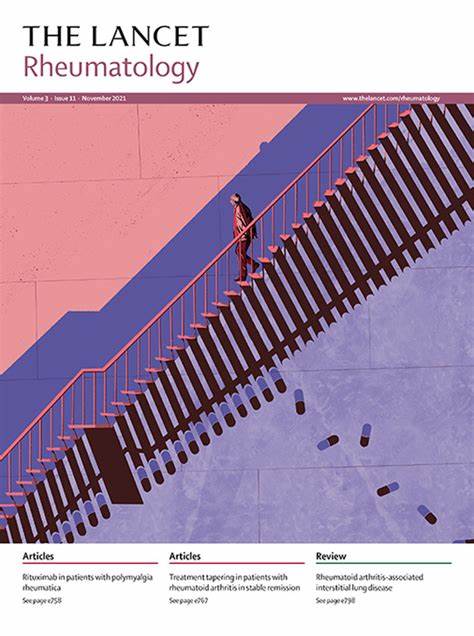Combinations of immunomodulatory agents for prevention of uveitis relapse in patients with severe Behçet's disease already on corticosteroid therapy: a randomised, open-label, head-to-head trial
IF 16.4
1区 医学
Q1 RHEUMATOLOGY
引用次数: 0
Abstract
Background
Data from head-to-head trials of immunomodulatory therapies for Behçet's disease are scarce. We aimed to compare the efficacy and safety of ciclosporin, interferon alfa-2a, and adalimumab, each combined with corticosteroids, in preventing uveitis relapse in patients with severe Behçet's disease.
Methods
We did a randomised, open-label, assessor-masked, head-to-head trial at a large, specialised uveitis centre in Chongqing, China. Patients aged 18 years or older with severe Behçet's disease uveitis on corticosteroids and naive to anti-TNF therapy were eligible. Patients were randomly assigned in a 1:1:1 ratio to ciclosporin (2–5 mg/kg per day orally), interferon alfa-2a (3 million IU per day subcutaneously), or adalimumab (40 mg every 2 weeks subcutaneously), each combined with a tapering dose of corticosteroids with subsequent dose adjustments. The primary outcome was the annualised relapse rate of uveitis, assessed in the full analysis set (all randomly assigned patients with at least one post-baseline assessment). The non-inferiority margin of difference between the interferon alfa-2a and adalimumab groups was set to 1·0 for the primary outcome. Safety was assessed in all patients who received at least one dose of trial drugs. Individuals with lived experience of Behçet's disease uveitis were involved in the trial design and implementation. This study is registered with Chinese Clinical Trial Registry, ChiCTR2000031637. The trial is ongoing, but is closed to new participants.
Findings
Between May 12, 2020, and Feb 22, 2022, a total of 270 patients (mean age 38·1 years [SD 9·8]; 213 [79%] men, 57 [21%] women; 270 [100%] east Asian ethnicity) were randomly assigned to ciclosporin, interferon alfa-2a, or adalimumab (n=90 in each group); 261 patients were included in the full analysis set. For the primary outcome, the least-squares mean was 1·84 (95% CI 1·40 to 2·44) with ciclosporin, 1·44 (1·10 to 1·89) with interferon alfa-2a, and 0·95 (0·64 to 1·40) with adalimumab. The annualised relapse rate was significantly higher in patients receiving ciclosporin than in those receiving adalimumab (least-squares mean difference 0·90 [95% CI 0·27 to 1·53]; p=0·0054 for superiority). The least-squares mean difference between interferon alfa-2a and adalimumab was 0·50 (–0·04 to 1·04), which did not meet non-inferiority criteria (p=0·034 for non-inferiority). The primary outcome did not differ substantially between interferon alfa-2a and ciclosporin (least-squares mean difference –0·40 [–1·05 to 0·25]; p=0·23 for superiority). Serious adverse events were reported in 12 (13%) of 90 patients on ciclosporin plus corticosteroids, eight (9%) of 90 patients on interferon alfa-2a plus corticosteroids, and seven (8%) of 90 patients on adalimumab plus corticosteroids. There were no treatment-related deaths.
Interpretation
Adalimumab plus corticosteroids was superior to ciclosporin plus corticosteroids with respect to uveitis relapse rate in patients with severe Behçet's disease naive to anti-TNF therapy, and interferon alfa-2a plus corticosteroids was not found to be non-inferior to adalimumab plus corticosteroids or superior to ciclosporin plus corticosteroids.
Funding
National Natural Science Foundation of China Key Program, Major Program of Medical Science and Technology Project of Health Commission of Henan Province, Chongqing Key Laboratory of Ophthalmology, and China National Postdoctoral Program for Innovative Talents.
联合使用免疫调节剂预防已接受皮质类固醇治疗的重症贝赫切特病患者葡萄膜炎复发:一项随机、开放标签、头对头试验。
背景:贝赫切特病免疫调节疗法的头对头试验数据很少。我们旨在比较环孢素、干扰素 alfa-2a 和阿达木单抗(每种药物均与皮质类固醇联合使用)在预防重症贝赫切特病患者葡萄膜炎复发方面的疗效和安全性:我们在中国重庆的一家大型葡萄膜炎专科中心进行了一项随机、开放标签、评估者掩蔽、头对头试验。年龄在18岁或18岁以上、患有严重贝赫切特病葡萄膜炎、使用皮质类固醇且对抗肿瘤坏死因子治疗不敏感的患者均符合条件。患者按1:1:1的比例被随机分配到环孢素(每天口服2-5毫克/千克)、干扰素α-2a(每天皮下注射300万IU)或阿达木单抗(每2周皮下注射40毫克)治疗方案中,每种方案均与皮质类固醇渐减剂量相结合,并在随后调整剂量。主要结果是葡萄膜炎的年复发率,在完整的分析集中进行评估(所有随机分配的患者至少有一次基线后评估)。干扰素α-2a组与阿达木单抗组之间的非劣效性差异幅度为1-0。所有接受过至少一剂试验药物治疗的患者都接受了安全性评估。具有贝赫切特病葡萄膜炎临床经验的人员参与了试验的设计和实施。该研究已在中国临床试验注册中心(ChiCTR2000031637)注册。试验仍在进行中,但已不再接受新参与者:2020年5月12日至2022年2月22日期间,共有270名患者(平均年龄38-1岁[SD 9-8];213名[79%]男性,57名[21%]女性;270名[100%]东亚裔)被随机分配到环孢素、干扰素alfa-2a或阿达木单抗治疗组(每组90人);261名患者被纳入完整分析集。就主要结果而言,环孢素的最小二乘平均值为1-84(95% CI为1-40至2-44),干扰素alfa-2a为1-44(1-10至1-89),阿达木单抗为0-95(0-64至1-40)。接受环孢素治疗的患者的年复发率明显高于接受阿达木单抗治疗的患者(最小二乘平均差为0-90 [95% CI 0-27至1-53];优越性P=0-0054)。干扰素α-2a与阿达木单抗之间的最小二乘平均差为0-50(-0-04至1-04),不符合非劣效性标准(非劣效性P=0-034)。干扰素α-2a与环孢素的主要疗效差异不大(最小二乘均值差-0-40[-1-05至0-25];P=0-23为优效)。在接受环孢素加皮质类固醇治疗的 90 位患者中,有 12 位(13%)、接受干扰素 alfa-2a 加皮质类固醇治疗的 90 位患者中,有 8 位(9%)、接受阿达木单抗加皮质类固醇治疗的 90 位患者中,有 7 位(8%)报告了严重不良事件。没有与治疗相关的死亡病例:阿达木单抗加皮质类固醇在对抗肿瘤坏死因子治疗无知的重症贝赫切特病患者葡萄膜炎复发率方面优于环孢素加皮质类固醇,而干扰素α-2a加皮质类固醇的疗效不优于阿达木单抗加皮质类固醇,也不优于环孢素加皮质类固醇:国家自然科学基金重点项目、河南省卫计委医学科技重大专项、重庆市眼科重点实验室、国家博士后创新人才计划。
本文章由计算机程序翻译,如有差异,请以英文原文为准。
求助全文
约1分钟内获得全文
求助全文
来源期刊

Lancet Rheumatology
RHEUMATOLOGY-
CiteScore
34.70
自引率
3.10%
发文量
279
期刊介绍:
The Lancet Rheumatology, an independent journal, is dedicated to publishing content relevant to rheumatology specialists worldwide. It focuses on studies that advance clinical practice, challenge existing norms, and advocate for changes in health policy. The journal covers clinical research, particularly clinical trials, expert reviews, and thought-provoking commentary on the diagnosis, classification, management, and prevention of rheumatic diseases, including arthritis, musculoskeletal disorders, connective tissue diseases, and immune system disorders. Additionally, it publishes high-quality translational studies supported by robust clinical data, prioritizing those that identify potential new therapeutic targets, advance precision medicine efforts, or directly contribute to future clinical trials.
With its strong clinical orientation, The Lancet Rheumatology serves as an independent voice for the rheumatology community, advocating strongly for the enhancement of patients' lives affected by rheumatic diseases worldwide.
 求助内容:
求助内容: 应助结果提醒方式:
应助结果提醒方式:


